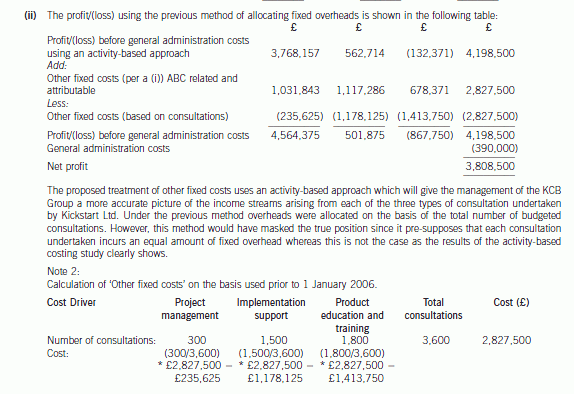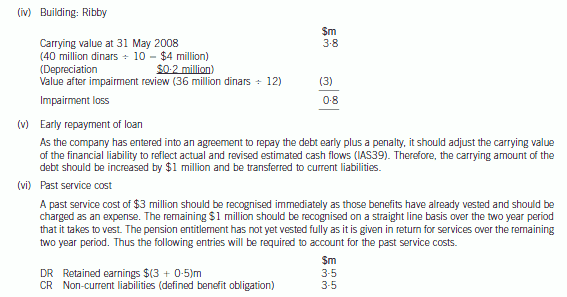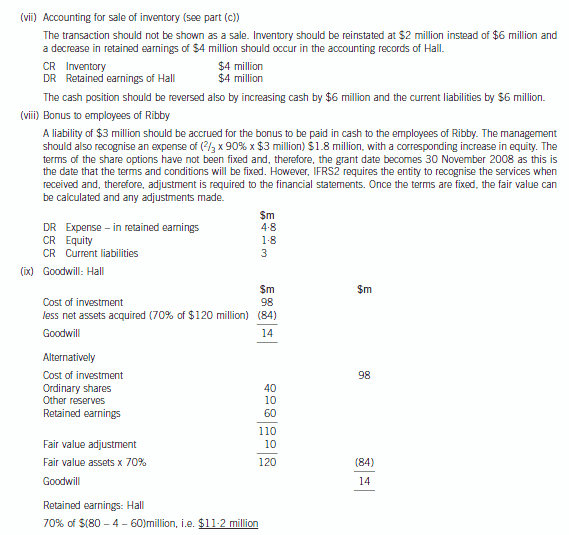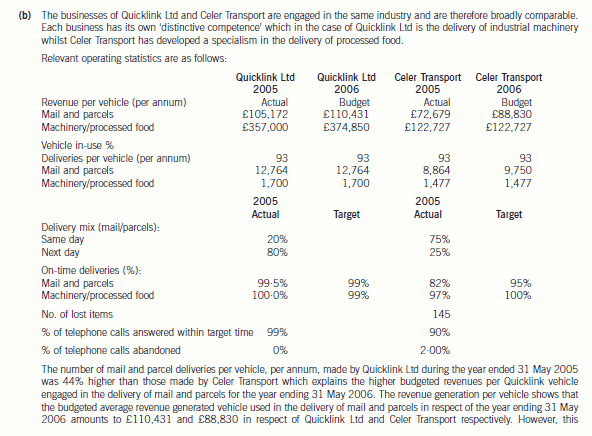(b) Using the information provided, state the financial statement risks arising and justify an appropriate audit
approach for Indigo Co for the year ending 31 December 2005. (14 marks)
第1题:
(ii) Explain the accounting treatment under IAS39 of the loan to Bromwich in the financial statements of
Ambush for the year ended 30 November 2005. (4 marks)
第2题:
(b) Describe with suitable calculations how the goodwill arising on the acquisition of Briars will be dealt with in
the group financial statements and how the loan to Briars should be treated in the financial statements of
Briars for the year ended 31 May 2006. (9 marks)
(b) IAS21 ‘The Effects of Changes in Foreign Exchange Rates’ requires goodwill arising on the acquisition of a foreign operation
and fair value adjustments to acquired assets and liabilities to be treated as belonging to the foreign operation. They should
be expressed in the functional currency of the foreign operation and translated at the closing rate at each balance sheet date.
Effectively goodwill is treated as a foreign currency asset which is retranslated at the closing rate. In this case the goodwillarising on the acquisition of Briars would be treated as follows:

At 31 May 2006, the goodwill will be retranslated at 2·5 euros to the dollar to give a figure of $4·4 million. Therefore this
will be the figure for goodwill in the balance sheet and an exchange loss of $1·4 million recorded in equity (translation
reserve). The impairment of goodwill will be expensed in profit or loss to the value of $1·2 million. (The closing rate has been
used to translate the impairment; however, there may be an argument for using the average rate.)
The loan to Briars will effectively be classed as a financial liability measured at amortised cost. It is the default category for
financial liabilities that do not meet the definition of financial liabilities at fair value through profit or loss. For most entities,
most financial liabilities will fall into this category. When a financial liability is recognised initially in the balance sheet, the
liability is measured at fair value. Fair value is the amount for which a liability can be settled, between knowledgeable, willing
parties in an arm’s length transaction. In other words, fair value is an actual or estimated transaction price on the reporting
date for a transaction taking place between unrelated parties that have adequate information about the asset or liability being
measured.
Since fair value is a market transaction price, on initial recognition fair value generally is assumed to equal the amount of
consideration paid or received for the financial asset or financial liability. Accordingly, IAS39 specifies that the best evidence
of the fair value of a financial instrument at initial recognition generally is the transaction price. However for longer-term
receivables or payables that do not pay interest or pay a below-market interest, IAS39 does require measurement initially at
the present value of the cash flows to be received or paid.
Thus in Briars financial statements the following entries will be made:

第3题:
(b) Explain how the non-payment of contributions and the change in the pension benefits should be treated in
the financial statements of Savage for the year ended 31 October 2005. (4 marks)
第4题:
(ii) Using the previous overhead allocation basis (as per note 4), calculate the budgeted profit/(loss)
attributable to each type of service for the year ending 31 December 2006 and comment on the results
obtained using the previous and revised methods of overhead allocation. (5 marks)

第5题:
(b) Discuss the relative costs to the preparer and benefits to the users of financial statements of increased
disclosure of information in financial statements. (14 marks)
Quality of discussion and reasoning. (2 marks)
第6题:
(b) (i) Discuss the main factors that should be taken into account when determining how to treat gains and
losses arising on tangible non-current assets in a single statement of financial performance. (8 marks)
第7题:
(b) Prepare a consolidated statement of financial position of the Ribby Group at 31 May 2008 in accordance
with International Financial Reporting Standards. (35 marks)








第8题:
4 Ryder, a public limited company, is reviewing certain events which have occurred since its year end of 31 October
2005. The financial statements were authorised on 12 December 2005. The following events are relevant to the
financial statements for the year ended 31 October 2005:
(i) Ryder has a good record of ordinary dividend payments and has adopted a recent strategy of increasing its
dividend per share annually. For the last three years the dividend per share has increased by 5% per annum.
On 20 November 2005, the board of directors proposed a dividend of 10c per share for the year ended
31 October 2005. The shareholders are expected to approve it at a meeting on 10 January 2006, and a
dividend amount of $20 million will be paid on 20 February 2006 having been provided for in the financial
statements at 31 October 2005. The directors feel that a provision should be made because a ‘valid expectation’
has been created through the company’s dividend record. (3 marks)
(ii) Ryder disposed of a wholly owned subsidiary, Krup, a public limited company, on 10 December 2005 and made
a loss of $9 million on the transaction in the group financial statements. As at 31 October 2005, Ryder had no
intention of selling the subsidiary which was material to the group. The directors of Ryder have stated that there
were no significant events which have occurred since 31 October 2005 which could have resulted in a reduction
in the value of Krup. The carrying value of the net assets and purchased goodwill of Krup at 31 October 2005
were $20 million and $12 million respectively. Krup had made a loss of $2 million in the period 1 November
2005 to 10 December 2005. (5 marks)
(iii) Ryder acquired a wholly owned subsidiary, Metalic, a public limited company, on 21 January 2004. The
consideration payable in respect of the acquisition of Metalic was 2 million ordinary shares of $1 of Ryder plus
a further 300,000 ordinary shares if the profit of Metalic exceeded $6 million for the year ended 31 October
2005. The profit for the year of Metalic was $7 million and the ordinary shares were issued on 12 November
2005. The annual profits of Metalic had averaged $7 million over the last few years and, therefore, Ryder had
included an estimate of the contingent consideration in the cost of the acquisition at 21 January 2004. The fair
value used for the ordinary shares of Ryder at this date including the contingent consideration was $10 per share.
The fair value of the ordinary shares on 12 November 2005 was $11 per share. Ryder also made a one for four
bonus issue on 13 November 2005 which was applicable to the contingent shares issued. The directors are
unsure of the impact of the above on earnings per share and the accounting for the acquisition. (7 marks)
(iv) The company acquired a property on 1 November 2004 which it intended to sell. The property was obtained
as a result of a default on a loan agreement by a third party and was valued at $20 million on that date for
accounting purposes which exactly offset the defaulted loan. The property is in a state of disrepair and Ryder
intends to complete the repairs before it sells the property. The repairs were completed on 30 November 2005.
The property was sold after costs for $27 million on 9 December 2005. The property was classified as ‘held for
sale’ at the year end under IFRS5 ‘Non-current Assets Held for Sale and Discontinued Operations’ but shown at
the net sale proceeds of $27 million. Property is depreciated at 5% per annum on the straight-line basis and no
depreciation has been charged in the year. (5 marks)
(v) The company granted share appreciation rights (SARs) to its employees on 1 November 2003 based on ten
million shares. The SARs provide employees at the date the rights are exercised with the right to receive cash
equal to the appreciation in the company’s share price since the grant date. The rights vested on 31 October
2005 and payment was made on schedule on 1 December 2005. The fair value of the SARs per share at
31 October 2004 was $6, at 31 October 2005 was $8 and at 1 December 2005 was $9. The company has
recognised a liability for the SARs as at 31 October 2004 based upon IFRS2 ‘Share-based Payment’ but the
liability was stated at the same amount at 31 October 2005. (5 marks)
Required:
Discuss the accounting treatment of the above events in the financial statements of the Ryder Group for the year
ended 31 October 2005, taking into account the implications of events occurring after the balance sheet date.
(The mark allocations are set out after each paragraph above.)
(25 marks)
第9题:
(c) Using information from the case, assess THREE risks to the Giant Dam Project. (9 marks)
第10题:
(b) Comment (with relevant calculations) on the performance of the business of Quicklink Ltd and Celer
Transport during the year ended 31 May 2005 and, insofar as the information permits, its projected
performance for the year ending 31 May 2006. Your answer should specifically consider:
(i) Revenue generation per vehicle
(ii) Vehicle utilisation and delivery mix
(iii) Service quality. (14 marks)

difference will reduce in the year ending 31 May 2006 due to the projected growth in sales volumes of the Celer Transport
business. The average mail/parcels delivery of mail/parcels per vehicle of the Quicklink Ltd part of the business is budgeted
at 12,764 which is still 30·91% higher than that of the Celer Transport business.
As far as specialist activities are concerned, Quicklink Ltd is budgeted to generate average revenues per vehicle amounting to
£374,850 whilst Celer Transport is budgeted to earn an average of £122,727 from each of the vehicles engaged in delivery
of processed food. It is noticeable that all contracts with major food producers were renewed on 1 June 2005 and it would
appear that there were no increases in the annual value of the contracts with major food producers. This might have been
the result of a strategic decision by the management of the combined entity in order to secure the future of this part of the
business which had been built up previously by the management of Celer Transport.
Each vehicle owned by Quicklink Ltd and Celer Transport is in use for 340 days during each year, which based on a
365 day year would give an in use % of 93%. This appears acceptable given the need for routine maintenance and repairs
due to wear and tear.
During the year ended 31 May 2005 the number of on-time deliveries of mail and parcel and industrial machinery deliveries
were 99·5% and 100% respectively. This compares with ratios of 82% and 97% in respect of mail and parcel and processed
food deliveries made by Celer Transport. In this critical area it is worth noting that Quicklink Ltd achieved their higher on-time
delivery target of 99% in respect of each activity whereas Celer Transport were unable to do so. Moreover, it is worth noting
that Celer Transport missed their target time for delivery of food products on 975 occasions throughout the year 31 May 2005
and this might well cause a high level of customer dissatisfaction and even result in lost business.
It is interesting to note that whilst the businesses operate in the same industry they have a rather different delivery mix in
terms of same day/next day demands by clients. Same day deliveries only comprise 20% of the business of Quicklink Ltd
whereas they comprise 75% of the business of Celer Transport. This may explain why the delivery performance of Celer
Transport with regard to mail and parcel deliveries was not as good as that of Quicklink Ltd.
The fact that 120 items of mail and 25 parcels were lost by the Celer Transport business is most disturbing and could prove
damaging as the safe delivery of such items is the very substance of the business and would almost certainly have resulted
in a loss of customer goodwill. This is an issue which must be addressed as a matter of urgency.
The introduction of the call management system by Quicklink Ltd on 1 June 2004 is now proving its worth with 99% of calls
answered within the target time of 20 seconds. This compares favourably with the Celer Transport business in which only
90% of a much smaller volume of calls were answered within a longer target time of 30 seconds. Future performance in this
area will improve if the call management system is applied to the Celer Transport business. In particular, it is likely that the
number of abandoned calls will be reduced and enhance the ‘image’ of the Celer Transport business.

